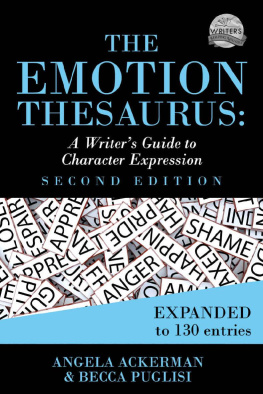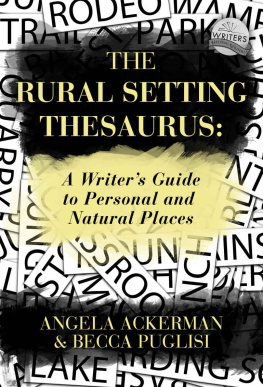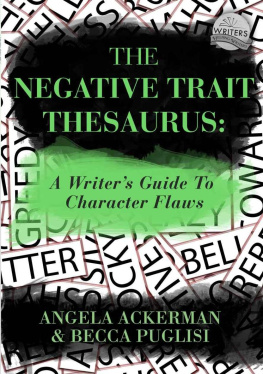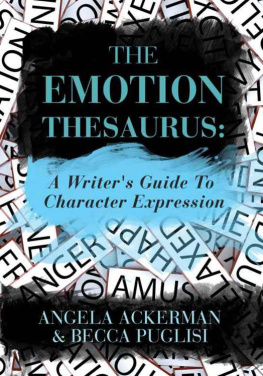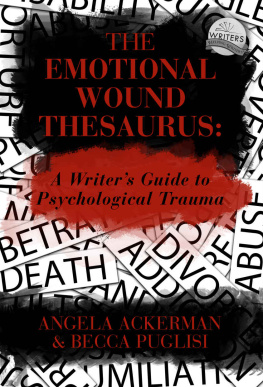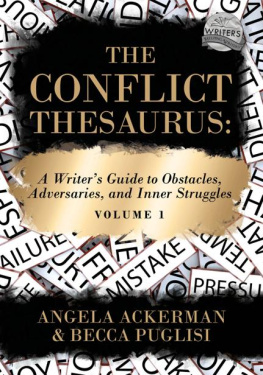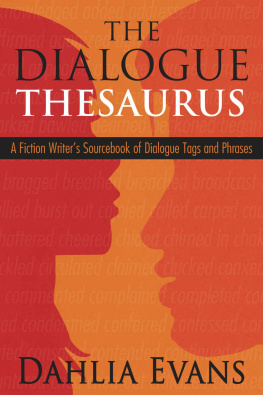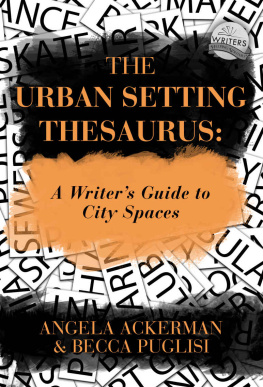Angela Ackerman - The Emotion Thesaurus: A Writer’s Guide to Character Expression
Here you can read online Angela Ackerman - The Emotion Thesaurus: A Writer’s Guide to Character Expression full text of the book (entire story) in english for free. Download pdf and epub, get meaning, cover and reviews about this ebook. year: 2019, publisher: JADD Publishing, genre: Romance novel. Description of the work, (preface) as well as reviews are available. Best literature library LitArk.com created for fans of good reading and offers a wide selection of genres:
Romance novel
Science fiction
Adventure
Detective
Science
History
Home and family
Prose
Art
Politics
Computer
Non-fiction
Religion
Business
Children
Humor
Choose a favorite category and find really read worthwhile books. Enjoy immersion in the world of imagination, feel the emotions of the characters or learn something new for yourself, make an fascinating discovery.
- Book:The Emotion Thesaurus: A Writer’s Guide to Character Expression
- Author:
- Publisher:JADD Publishing
- Genre:
- Year:2019
- Rating:5 / 5
- Favourites:Add to favourites
- Your mark:
- 100
- 1
- 2
- 3
- 4
- 5
The Emotion Thesaurus: A Writer’s Guide to Character Expression: summary, description and annotation
We offer to read an annotation, description, summary or preface (depends on what the author of the book "The Emotion Thesaurus: A Writer’s Guide to Character Expression" wrote himself). If you haven't found the necessary information about the book — write in the comments, we will try to find it.
The Emotion Thesaurus: A Writer’s Guide to Character Expression — read online for free the complete book (whole text) full work
Below is the text of the book, divided by pages. System saving the place of the last page read, allows you to conveniently read the book "The Emotion Thesaurus: A Writer’s Guide to Character Expression" online for free, without having to search again every time where you left off. Put a bookmark, and you can go to the page where you finished reading at any time.
Font size:
Interval:
Bookmark:
THE EMOTION THESAURUS: A Writers Guide to Character Expression Second Edition ANGELA ACKERMAN BECCA PUGLISI THE EMOTION THESAURUS: A WRITERS GUIDE TO CHARACTER EXPRESSION. Copyright 2012, 2019 by Angela Ackerman & Becca Puglisi All rights reserved Writers Helping Writers No part of this publication may be reproduced or distributed in print or electronic form without prior permission of the authors. Please respect the hard work of the authors and do not participate in or encourage the piracy of copyrighted materials. First edition published in 2012 Second edition published in 2019 ISBN: 978-0-9992963-5-6 (Second Edition) Edited in part by Michael Dunne Book cover design by: JD Smith Design Book formatting by: JD Smith Design ACKNOWLEDGEMENTS First and foremost, we want to thank readers of The Bookshelf Muse and Writers Helping Writers for their support, encouragement, and kind words. You made us see the need for a book version of The Emotion Thesaurus , and your belief in us made it happen. We also want to acknowledge the very important members of our first critique group: Helen (Bookish), Roy (Grampy), Madeline (Maddog), Joan (Unohoo), and Laura (Goofus).
These Critique Circle writers helped us kick start this list and our respective writing careers. Our deepest appreciation also goes to our friend Sharon, who encouraged us when we needed it most. We also owe a huge debt to the writing community at large. The writers we have met online, at conferences, at face-to-face groups, and in our own communities have been so generous with their knowledge and optimism, enabling us each to grow as writers. We love being part of this group. And finally, the biggest shout out goes to our families, who supported us though they couldnt see the vision, encouraged us when we struggled, and provided the business savvy we were lacking.
We owe it all to you. ~To AAD and SDJ, with all our love~ MORE WRITERS HELPING WRITERS BOOKS The Positive Trait Thesaurus: A Writers Guide to Character Attributes The Negative Trait Thesaurus: A Writers Guide to Character Flaws The Urban Setting Thesaurus: A Writers Guide to City Spaces The Rural Setting Thesaurus: A Writers Guide to Personal and Natural Places The Emotional Wound Thesaurus: A Writers Guide to Psychological Trauma Emotion Amplifiers: A Companion to The Emotion Thesaurus Table Of Contents INTRODUCTION TO THE SECOND EDITION When we first released The Emotion Thesaurus almost seven years ago, it was with enormous trepidation. This was our first nonfiction project, and what we didnt know about self-publishing would have filled its own book. What we did recognize was our own difficulty conveying character emotion in a way that would engage readers. This problem is a big one, because only when the characters emotions are clearly shared can readers become more involved. We wanted to ensure that our characters feelings would trigger the readers own emotional memories, encouraging empathy that would draw them deeper into the story.
Based on a hunch that other writers also had this problem, we set out to provide a solution with The Emotion Thesaurus. It wasnt clear just how common the problem was until we saw the response to our booka response that continues to amaze and humble us. Our hypothesis confirmed, we dug deeper into this topic, and as we expanded our own knowledge, it became clear that we had more to share. Hence, our decision to release an updated edition of The Emotion Thesaurus. The instructional material in the first part of the book continues to offer its unique how-to cocktail of writing emotion and show-dont-tell tips but with some powerful new additions. Its been expanded to include a section on how dialogue can and should be used to convey a characters feelings.
Weve also explored the critical part subtext plays in natural conversation and how it can be written to show hidden emotion. And because backstory figures so heavily into characterization, weve added information on what research should be done to establish your characters wounding events and emotional range, which will allow you to write their responses realistically and consistently. As for the emotions themselves, we now have a total of 130 entries, each of which contains a list of the physical cues, thoughts, and internal sensations that, chosen thoughtfully, will enable you to create the perfect responses for your character. Weve added power verbs so you can choose stronger words to describe associated actions, and sets of escalating and de-escalating emotions to help you visualize where a character might naturally go next. In short, we hope youll find the second edition of The Emotion Thesaurus to be even more useful than its predecessor. Our goal, as always, is to give you the methods and brainstorming tools that make it easier to write emotional moments that are fresh and evocative.
THE POWER OF EMOTION All successful novels, no matter what genre, have one thing in common: emotion. It lies at the core of every characters decision, action, and word, all of which drive the story. Without emotion, a characters personal journey is pointless. Stakes cease to exist. The plot line becomes a dry riverbed of meaningless events that no reader will take time to read. Why? Because above all else, readers pick up a book to have an emotional experience.
They read to connect with characters who provide entertainment and whose trials may add meaning to their own life journeys. As emotional beings, feelings propel us. They steer our choices, determine who we spend time with, and dictate our values. Emotion also fuels our communication, allowing us to share meaningful information and beliefs with others. And while it may seem that most exchanges happen through conversation, studies show that up to 93% of communication is nonverbal. Even in instances where we try not to show our feelings, we are still sending messages through body language and vocal cues.
Because of this, each of us becomes adept at reading others without a word being said. As writers, we must take our innate skills of observation and transfer them to the page. Readers have high expectations. They dont want to be told how a character feels; they want to experience the emotion for themselves. To make this happen, we must ensure that our characters express their feelings in ways that are both recognizable and compelling to read. Thankfully, the media for conveying emotion are customizable, so with a bit of elbow grease, writers can craft original, authentic responses personalized to every individual in the story.
VEHICLES FOR SHOWING EMOTION Dialogue is what we use to articulate our ideas, thoughts, beliefs, and needs, all of which are driven by our emotional state. What we feel always propels us, but it is rare to refer to those feelings directly in conversation. So while dialogue is a proven vehicle for sharing a characters emotions, it rarely should do so alone. To convey feelings well, a writer should also utilize nonverbal communication, which can be broken down into four additional vehicles: vocal cues, body language, thoughts, and visceral reactions. Vocal Cues are shifts in the voice that supply readers with valuable hints about the speakers emotional state. In conversation, there isnt always time to think about how to react, so while a person might disguise their true feelings by choosing their words carefully, their tone of voice or the flow of words wont be as easy to control.
Hesitations, a voice that changes tone or pitch, words that suddenly slide out fasterall of these are terrific indicators that a characters emotions have changed and theres more to the exchange than meets the eye. Vocal cues can be especially useful for showing the feelings of a non-point-of-view character, since, in most written viewpoints, their direct thoughts cannot be shared with the reader. Body Language is how our bodies outwardly respond when we experience emotion. The stronger the feeling, the more we react and the less conscious control we have over movement. Because characters are unique, they will express themselves in a specific way.
Next pageFont size:
Interval:
Bookmark:
Similar books «The Emotion Thesaurus: A Writer’s Guide to Character Expression»
Look at similar books to The Emotion Thesaurus: A Writer’s Guide to Character Expression. We have selected literature similar in name and meaning in the hope of providing readers with more options to find new, interesting, not yet read works.
Discussion, reviews of the book The Emotion Thesaurus: A Writer’s Guide to Character Expression and just readers' own opinions. Leave your comments, write what you think about the work, its meaning or the main characters. Specify what exactly you liked and what you didn't like, and why you think so.

